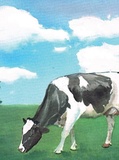Improving udder health management in dairy herds with automatic milking systems

Deng, Zhaoju
- Promoter:
- Prof.dr T.J.G.M. (Theo) Lam & dr. Ir. H. (Henk) Hogeveen
- Co-promoter:
- Dr. G. (Geert) Koop
- Research group:
- Lam
- Date:
- July 15, 2021
- Time:
- 10:30 h
Summary
The increased use of automatic milking systems (AMS) in combination with modern sensor and big data technologies enables a transformation of mastitis management in dairy herds worldwide. This thesis describes that most risk factors in dairy herds using AMS are the same as in herds using a conventional milking system (CMS). However, the use of an AMS asks for specific attention for environmental mastitis. Hygiene of dairy cows and milking machine, which is related to the infectious pressure of environmental mastitis pathogens, is even more important in AMS than in CMS. On the other hand, transmission parameters of contagious pathogens seem lower in AMS than in CMS dairy herds. The use of AMS does not result in impaired udder health status or more antimicrobial usage in AMS herds than in CMS herds. In both types of herds, antimicrobial use is associated with the attitude of the farmer to the subject.
The potential use and benefit of frequently measured and automated mastitis indicators to optimize on-farm mastitis decision making is evaluated by using a number of state-of-the-art statistical and epidemiological modeling methods. It was found that using sensor-based mastitis indicators is valuable for different aspects of preventive mastitis management as well as for decisions on the use of antimicrobials to treat mastitis. Modern sensor technology holds great potential to support mastitis management and gives new insights in the infection dynamics of mastitis in dairy cows, of which the regularly fluctuating somatic cell count described in this thesis is a fascinating example.